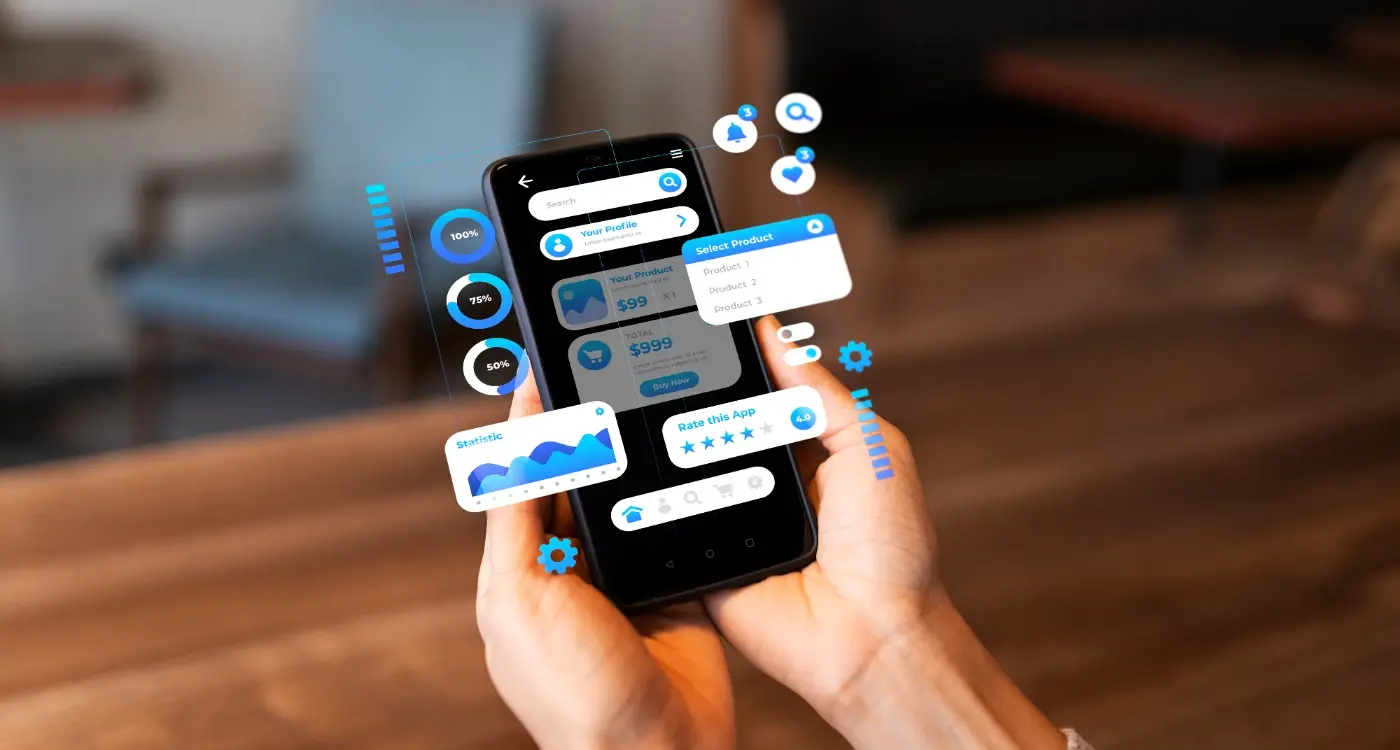Why Should I Choose Behavioural Design For My App?
I've been working in mobile app development for over eight years now, and I can tell you something that might surprise you—most apps fail not because they're broken, but because they don't understand people. That's right, the biggest problem isn't bugs or crashes; it's that developers build apps thinking logically when users behave emotionally.
You see, every time someone opens your app, taps a button, or swipes through a screen, they're making decisions based on psychology. They might not realise it—most people don't—but their brains are constantly evaluating whether your app feels rewarding, frustrating, helpful, or confusing. This is where behavioural app design comes in, and frankly, it's what separates successful apps from the millions gathering digital dust in app stores.
The best apps don't just solve problems—they understand the human brain well enough to make solving those problems feel natural and rewarding
Throughout this guide, we'll explore how psychology-driven development can transform your app from something people download and forget to something they genuinely want to use. We'll look at user psychology apps that have mastered behavioural UX design, and more importantly, show you how to apply these principles to your own project. Trust me, once you start thinking about apps through the lens of human behaviour, you'll never design the same way again.
What Is Behavioural Design and Why Does It Matter
I'll be honest with you—when I first heard the term "behavioural design" I thought it sounded like marketing fluff. Another buzzword to impress clients, right? But after years of watching apps succeed and fail, I've come to realise it's one of the most powerful tools we have as app developers. Behavioural design is simply using what we know about human psychology to create apps that people actually want to use.
Think about it this way: your users aren't robots making logical decisions. They're humans with emotions, habits, and quirks. They forget passwords, they get distracted by notifications, and they abandon shopping carts halfway through checkout. Behavioural design acknowledges these very human traits and works with them rather than against them.
The Psychology Behind User Actions
When we design apps using behavioural principles, we're tapping into the subconscious triggers that drive user behaviour. Things like social proof (showing how many people liked a post), loss aversion (limited time offers), and the desire for instant gratification all play massive roles in whether someone continues using your app or deletes it.
Why Traditional Design Falls Short
Traditional app design focuses on making things look pretty and function well. That's brilliant, but it misses something crucial—the human element. You can have the most beautiful interface in the world, but if it doesn't understand how people actually behave, you'll struggle to keep users engaged.
- Users make decisions based on emotion first, logic second
- People form habits through repetition and rewards
- Social influence affects almost every choice we make
- Cognitive biases shape how we perceive value and risk
Behavioural design matters because it bridges the gap between what users say they want and what they actually do. It's the difference between an app that gets downloaded and one that gets used daily.
Understanding How Your Users Really Think
Here's something I learned the hard way after watching countless apps fail—people don't always do what they say they'll do. You can survey users until you're blue in the face, asking them what features they want or how they'd use your app, but their actual behaviour tells a completely different story. That gap between intention and action? That's where behavioural app design becomes your secret weapon.
Users make decisions with their emotions first, then justify with logic later. They're also terrible at predicting their own future behaviour. Someone might tell you they'd love a detailed fitness tracking app with twenty different metrics, but in reality they just want to hit a big green button that says "I exercised today" and feel good about it. This is why understanding the emotional side of app design is so crucial for creating apps that succeed.
The Mental Shortcuts Your Users Take
Your brain is lazy—and that's not an insult, it's just efficient. Users rely on mental shortcuts called heuristics to make quick decisions. They'll choose the option that looks familiar, pick the item at the top of a list, or assume that bigger buttons are more important. Understanding these patterns means you can design with behavioural UX design principles that work with your users' natural thinking, rather than against it.
Watch what users do in your app analytics, not just what they tell you in surveys. The data reveals the truth about user psychology that people often can't articulate themselves.
The Science Behind User Habits and App Engagement
Here's something that might surprise you—most people check their phones over 100 times a day. That's not because they're addicted (well, not entirely), it's because apps have been designed to create habits. And there's proper science behind how this works.
When someone uses your app and gets a reward—like completing a task, getting a notification, or finding something useful—their brain releases a chemical called dopamine. Think of dopamine as your brain's way of saying "that was good, let's do it again!" The more often this happens, the stronger the habit becomes.
The Habit Loop That Keeps Users Coming Back
Every habit follows the same pattern: trigger, action, reward. In app terms, this might be a notification (trigger), opening your app (action), and finding something interesting (reward). The clever bit is that once this loop repeats enough times, people start opening your app without even thinking about it.
But here's where many app developers get it wrong—they focus too much on the reward and forget about the trigger. The best apps I've worked on don't just give users great experiences; they give users clear reasons to come back. Whether that's a daily reminder, a streak to maintain, or simply making the app icon impossible to ignore on their home screen, the trigger is what starts the whole process rolling. This is exactly what top mobile apps use to hook users and keep them coming back day after day.
Applying Psychology to Create Better User Experiences
Right, let's get practical. You understand the theory behind behavioural app design, but how do you actually put user psychology into practice? The truth is, it's easier than you might think—once you know what to look for.
Start with your onboarding flow. This is where psychology-driven development really shines. People hate being overwhelmed with choices (it's called decision paralysis), so keep your initial screens simple. One clear action per screen works wonders. I've seen apps fail because they threw everything at users from the get-go.
The Power of Progressive Disclosure
Show users just enough to keep them moving forward; reveal features gradually as they become comfortable. It's like teaching someone to drive—you don't start with motorways! Use visual cues and micro-interactions to guide behaviour naturally.
The best behavioural UX design feels invisible to users—they just know exactly what to do next without thinking about it
Social proof is another game-winner. Show user reviews, ratings, or how many people have completed an action. We're social creatures who look to others for validation. Even something as simple as "Join 10,000+ happy users" can boost conversions significantly. The key is making these psychological triggers feel authentic, not manipulative.
Common Behavioural Design Mistakes That Kill Apps
After working with countless app projects over the years, I've seen the same behavioural design mistakes pop up again and again. These aren't technical bugs or visual design flaws—they're fundamental misunderstandings about how people actually use apps. The worst part? Most of these mistakes could have been avoided with just a bit more thought about user psychology.
The Big Four App-Killers
Here are the behavioural design mistakes I see most often, and trust me, they can destroy even the most promising apps:
- Overwhelming users with too many choices right from the start—choice paralysis is real
- Making the signup process longer than a shopping queue at Christmas
- Forgetting to show users the value before asking them to invest time or money
- Ignoring the power of small wins and instant gratification
The choice overload problem is particularly painful to watch. I've seen apps with beautiful interfaces completely fail because they dumped twenty different options on users within the first thirty seconds. People's brains simply shut down when faced with too many decisions.
Why These Mistakes Happen
Most of these errors stem from teams designing for themselves rather than their users. Developers and designers know their app inside out, so what feels simple to them can be overwhelming for someone opening the app for the first time. The key is stepping back and remembering that your users don't have your knowledge or patience. This is why good app design is so crucial for success—it's about creating experiences that work for real people, not just the people who built the app.
Measuring the Success of Psychology-Driven Development
Right, so you've built your app using behavioural design principles—now what? How do you know if all that psychology-driven development actually worked? I get asked this question loads, and honestly, it's not always straightforward to measure.
The thing is, traditional app metrics like downloads and daily active users only tell part of the story. When you're using behavioural UX design, you need to look deeper. You want to see if people are actually forming habits with your app, not just using it once and forgetting about it.
Key Metrics That Actually Matter
Here's what I track when measuring user psychology apps:
- Session frequency—how often users return
- Habit formation rate—users who stick around for 30+ days
- Feature adoption—which psychological triggers work best
- User journey completion—do people finish what they start?
- Emotional response data—through surveys and feedback
Track behavioural loops, not just vanity metrics. A user who opens your app three times a week for two minutes is often more valuable than someone who uses it once for an hour.
The real magic happens when you can see patterns in user behaviour that match your psychological design intentions. If you built a feature to create anticipation and users keep coming back at the same time each day, that's your proof it's working. This is where focusing on UX over UI becomes essential for creating meaningful, behaviour-driven experiences.
Real Examples of Behavioural UX Design That Works
Nothing beats seeing behavioural design in action—and trust me, when it's done right, the results speak for themselves. I've watched apps transform their user engagement simply by understanding what makes people tick.
Take Duolingo, for instance. They've mastered the art of habit formation by using streaks. Users don't want to break their learning streak, so they keep coming back daily. The owl mascot even sends gentle (sometimes not so gentle!) reminders when you miss a day. It's brilliant because it taps into our natural desire to maintain consistency.
Apps That Get It Right
- Spotify creates personalised playlists that feel like gifts—making users feel special and understood
- Instagram's infinite scroll keeps people engaged by removing natural stopping points
- Headspace uses progress tracking and achievement badges to make meditation feel rewarding
- Strava turns exercise into a social competition, leveraging our competitive nature
What I love about these examples is how the psychological triggers feel natural, not manipulative. The best behavioural app design doesn't trick users—it understands their motivations and works with them. Strava users genuinely want to improve their fitness; the app just makes the social aspect more engaging.
The Psychology Behind These Success Stories
Each of these apps taps into fundamental human drives. Duolingo uses loss aversion (don't break the streak!), Spotify leverages the endowment effect (this playlist was made just for you), and Instagram exploits variable reward schedules (you never know what interesting post comes next). The key insight? They all make users feel good about the behaviour they want to encourage.
What's particularly clever is how these apps layer multiple psychological principles together. They don't just use one behavioural trigger; they create entire systems that reinforce the habits they want to build. It's like having multiple safety nets to catch users before they drift away.
Getting Started With Behavioural Design in Your App
Alright, you're convinced that behavioural design is worth pursuing—but where do you actually start? I get this question constantly from developers who understand the theory but feel overwhelmed by the practical implementation. The good news is you don't need to revolutionise your entire app overnight.
Start small and test often. Pick one user journey in your app—maybe the onboarding flow or a key feature—and apply a single behavioural principle. Perhaps add some social proof to your signup page or create a small reward for completing a first action. Then measure what happens.
Your Behavioural Design Toolkit
Here's what I recommend for getting started with psychology-driven development:
- Map out your user's emotional journey, not just their functional path
- Identify friction points where users commonly drop off
- Add micro-rewards and positive feedback loops
- Use progressive disclosure to reduce cognitive load
- Implement social proof elements where they make sense
- Create clear triggers that bring users back
Remember, behavioural UX design isn't about manipulation—it's about removing barriers between users and the value your app provides. The best implementations feel so natural that users don't even notice the psychology at work; they just know your app feels right to use.
Start by observing your current users' behaviour patterns. What are they already doing that you could reinforce? Building on existing behaviours is often easier than creating entirely new ones.
The Future of User Psychology in App Development
Looking ahead, I reckon we're just scratching the surface of what's possible with behavioural app design. As we understand more about user psychology and get better tools for measuring emotional responses, apps are going to become far more sophisticated at understanding and responding to human behaviour.
Machine learning is already starting to personalise behavioural triggers based on individual user patterns. Imagine an app that knows you're most motivated by social recognition in the morning but prefer private achievements in the evening. That level of psychological customisation is coming sooner than you think.
Staying Ethical as We Get More Powerful
With great power comes great responsibility, and behavioural design is genuinely powerful. As developers, we need to use these psychological insights to help users achieve their own goals, not just to boost our metrics. The apps that will succeed long-term are those that create genuine value while respecting users' autonomy and wellbeing.
The future belongs to apps that understand people as well as they understand technology. Those developers who master both the technical and psychological sides of app development will create the experiences that truly change how people live and work.
Conclusion
Here's the thing about behavioural design—once you start seeing apps through the lens of human psychology, you can't unsee it. Every notification, every button placement, every colour choice becomes a conversation between the app and the user's subconscious mind.
Throughout this guide, we've explored how understanding user psychology can transform your app from something that merely functions to something people genuinely want to use. We've seen how the biggest app failures aren't technical—they're psychological. And we've learned that the most successful apps aren't just well-coded; they're designed with a deep understanding of human behaviour.
Behavioural app design isn't about tricking users or manipulating them into actions they don't want to take. It's about removing the friction between users and the value your app provides. It's about working with human nature rather than against it. It's about creating experiences that feel intuitive, rewarding, and genuinely helpful.
The apps winning in today's competitive market are those that understand something fundamental: people don't just download apps to complete tasks—they download them to feel something. To feel productive, connected, entertained, or accomplished. When you design with behavioural UX principles, you're not just building software; you're crafting experiences that resonate with the deepest parts of how humans think and feel.
So here's my challenge to you: take everything we've discussed and apply just one behavioural principle to your next app project. Start small, measure the results, and build from there. Watch how your users respond when you design for their psychology, not just their functionality needs.
The future of successful app development isn't just about better code or prettier interfaces—it's about better understanding the humans who use our creations. And that understanding starts with recognising that every tap, swipe, and decision your users make is driven by psychology. Master that, and you'll master the art of creating apps people can't put down.
Trust me, once you start thinking like a behavioural designer, you'll wonder how you ever built apps any other way.
Share this
Subscribe To Our Learning Centre
You May Also Like
These Related Guides

How Does Psychology Apply To Healthcare App Development?

What Are the Best Practices for AI-Driven User Interfaces?



